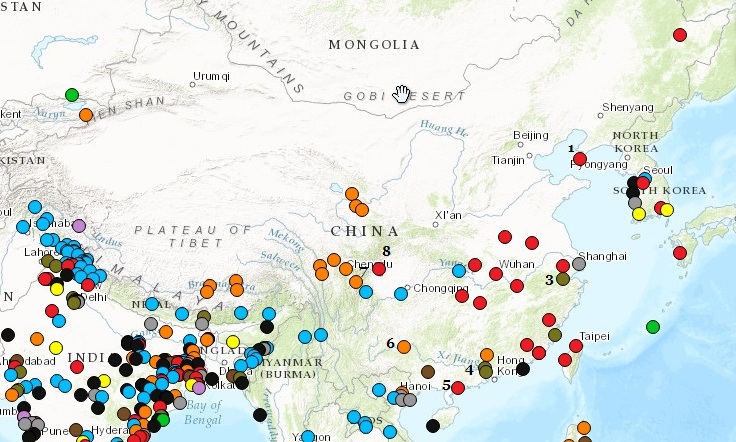BRICS FROM BELOW |
||
| HOME NEWS RESERCH SOLIDARITY MAPPING | ||
| PROTEST MAPPING | BRAZIL CHINA INDIA RUSSIA SOUTH AFRICA BRICS IN AFRICA | |
|
FILTER BY Keyword |
||
| |
PROTEST AND DISSENT IN CHINAIn spite of restrictions on freedom of association and of speech, a wide variety of protests and dissident movements have proliferated in China, particularly in the decades since the death of Mao Zedong. Among the most notable of these were the 1959 Tibetan uprising against Communist Party rule, the 1989 Tiananmen Square protests, which was put down with military force, and the 25 April 1999 demonstration by 10,000 Falun Gong practitioners at Zhongnanhai. Protesters and dissidents in China espouse a wide variety of grievances, including but not limited to corruption, forced evictions, unpaid wages, human rights abuses, environmental degradation, ethnic protests, petitioning for religious freedom and civil liberties, protests against one-party rule, as well as nationalist protests against foreign countries.The number of annual protests has grown steadily since the early 1990s, from approximately 8700 “mass group incidents” in 1993 to over 87,000 in 2005. In 2006, the Chinese Academy of Social Sciences estimated the number of annual mass incidents to exceed 90,000, and Chinese sociology professor Sun Liping estimated 180,000 incidents in 2010. Mass incidents are defined broadly as "planned or impromptu gathering that forms because of internal contradictions", and can include public speeches or demonstrations, physical clashes, public airings of grievances, and other group behaviors that are seen as disrupting social stability. Despite the increase in protests, some scholars have argued that they may not pose an existential threat to Communist Party rule because they lack “connective tissue;” the preponderance of protests in China are aimed at local-level officials, and only a select few dissident movements seek systemic change. https://en.wikipedia.org/wiki/Protest_and_dissent_in_China Fierce clashes at “Democracy village” China Worker 14 September 2016 Protesters defy crackdown Wukan in southern China is described as a “war zone” after hundreds of heavily armed police descended on the village this week, raiding houses during the night, arresting dozens and then confronting protesters with tear gas and rubber bullets. The crackdown, although ordered by the lower-level authorities, is the latest sign China has entered an ‘ice age’ of repression under Xi Jinping, who is engaged in a fierce top-level power struggle, while presiding over mass arrests of dissidents and unprecedented levels of media and internet censorship. “Most people have been scared badly,” a villager told James Pomfret of Reuters. “…This time it was a wild crackdown. They went after everyone, chasing them up into their houses, beating people.” http://www.socialistworld.net/doc/7723 China: violent protests reveal instability Jack Rising (Marxist.com) 20 May 2015 Thousands of protesters violently clashed with authorities last Saturday in Linshui County, located in eastern Sichuan province. The protesters demanded that a proposed high speed railway pass through Linshui. They were met with batons and rubber bullets, with hundreds reportedly being injured by the police and tactical units. The heavy handed response of the Chinese state to these protests reveals the instability and weakness of the regime. Around 20,000 protesters took to the streets of Linshui in support of the rail line. A letter written by a resident of Linshui addressed to the state authorities stated, “There are two railways passing through Guangan. We are the only county in the region that has nothing. http://www.marxist.com/china-violent-protests-reveal-instability.htm Miners’ strike while People’s Congress discusses mass redundancies Dikang, (chinaworker.info) 16 May 2016 Thousands march in Heilongjiang province opposing job cuts. Thousands of coal miners in the far northeast of China have been on strike for six days, demanding that China’s rulers – the so-called Communist Party dictatorship (CCP) – “give us back our money!” The protests, captured in dramatic video footage that is banned inside China, have shaken the Chinese regime during the very week when its ceremonial National People’s Congress (NPC) has been meeting in Beijing. A key discussion at the NPC has been about how the regime will cut the workforce in state-owned industries, with widely cited reports of 5-6 million redundancies, equivalent to one in six state sector jobs. The striking mineworkers of Heilongjiang province, a region already devastated by closures and layoffs, have given a courageous and resounding answer to these plans. http://www.socialistworld.net/doc/7511 A victory for protests in China and worldwide chinaworker.info reporters 14 April 2015 Five women activists released in rare climb down by Beijing regime The five feminists whose detention over a month ago sparked a global protest campaign were released on Monday 13 April. The women’s release represents a significant and rare climb down by the Chinese authorities in the face of mounting global protests. The Washington Post described the release as a “surprise move” and many had indeed feared the worst for these young activists as they were ensnared in the crackdown against protest and expression that has become the hallmark of Xi Jinping’s rule. “In some ways this retreat is the first significant crack in the wall as far as Xi Jinping’s massive campaign of state repression is concerned,” said Vincent Kolo, editor of chinaworker.info. http://www.socialistworld.net/doc/7167 50,000 strike at sports shoe manufacturers China Worker 29 April 2014 Local government, police and company bosses coordinate crackdown It is one of the biggest strikes in China for decades and has attracted international attention. The strike at factories owned by Yue Yuen Industrial Holdings in the Dongguan township of Gaobu is already one for the history books. Dongguan is in Guangdong province, which accounts for more than a fifth of China’s exports. The ruling ‘Communist’ Party (CCP) has been understandably nervous about such a massive protest, and the risk of a ripple effect. The strikers, up to 50,000 at one stage, demanded back payment of millions of yuan in unpaid social insurance and pension contributions. http://www.socialistworld.net/doc/6759 Tibetans in revolt: What is the way forward? China Worker 14 March 2013 Chinese regime’s repression responsible for Tibetan self-immolations March 14 is the fifth anniversary of the protests across Tibetan-populated regions against suffocating political and religious repression by the Communist Party (CCP) regime. This also coincides with the anniversary, on March 10, of the crushing of the Tibetan revolt of 1959. Up to 200 people lost their lives in the countdown to the Beijing Olympics in 2008, in the most serious upheavals in Tibet since 1989. The protests began peacefully, until repression by the state triggered riots and serious inter-ethnic clashes between Tibetans and Han Chinese, and led many in China to support the subsequent crackdown. Five years on, and the agony of Tibetans is expressed in a wave of horrific self-immolations. More than 100 ethnic Tibetans have set themselves on fire over the past two years in a shocking new method of protest against Chinese state repression. Of these suicides and attempted suicides, around one-fifth were just 18 years of age of younger. http://www.socialistworld.net/doc/6208 Guangdong village rebellion as ‘legislature’ meets in Beijing Zhang Shujie and Vincent Kolo, China Worker 10 March 2013 Spirit of Wukan revived with demands for democratic vote over land seizures Yet another Guangdong village has risen in revolt against illicit land sales. Yet another tense standoff is underway between protesters, at the end of their patience over official corruption, and large numbers of security personnel deployed by local CCP (Communist Party) leaders. The protests in Shangpu, which revive memories of the epic Wukan village rebellion of 2011, come at the worst possible time for the Chinese dictatorship. Last Tuesday the rubber-stamp National People’s Congress (NPC) opened its annual session, to cement the handover of power to Xi Jinping and the new princeling-dominated leadership. The struggle in Shangpu provides a vivid reminder of the stark economic reality for the masses, far away from the splendour and billionaire lifestyles of the CPP elite gathered in Beijing. China experiences more than 180,000 “mass incidents” every year – street marches, strikes or violent disturbances. Fully two-thirds of these incidents are related to the seizure of farmland for development. A joint study by US-based Landesa Rural Development Institute, Renmin University in Beijing and Michigan State University conducted in 2011 revealed that on average 4 million people lose their land to government expropriation every year. http://www.socialistworld.net/doc/6200 2,000 workers riot at Foxconn factory China Worker 26 September 2012 Brutal conditions behind latest flare-up at iPhone manufacturer Security guards are being blamed for triggering the mass riot at Foxconn’s huge factory in Shanxi province in northern China at the weekend – another example of the explosive tensions accumulating among super-exploited Chinese workers in gigantic prison-like sweatshops such as those run by Foxconn. Up to 2,000 workers were reportedly involved at the height of the unrest, with 40 people sent to hospital, as violent clashes continued for several hours from Sunday evening until Monday morning. News reports say that 5,000 police were called to the plant to restore order. According to Xinhua at least three of the injured are in serious condition. There are even reports of fatalities in some foreign media but this has been denied by Foxconn. http://www.socialistworld.net/mob/doc/5959 The Wukan uprising and its lessons Vincent Kolo and Zhang Shujie 23 February 2012 Workers’ strikes and new local rebellions use the slogan “Learn from Wukan” Wukan is the fishing village in southern China’s Guangdong province that achieved worldwide fame as a symbol of mass resistance. Like thousands of other rural communities in recent years, the 13,000 inhabitants of Wukan rose up against corrupt local officials who have stolen land and made millions in profits. But Wukan achieved something else, by displaying a new level of organisation and mass mobilisation, setting up independent popular committees and campaign structures. In so doing, Wukan has become a benchmark for future struggle in China. Its people waged a daring and impressive four-month long struggle that ejected the local ‘communist’ (Chinese Communist Party) government, and set up their own elected council to run the community. Finally, in the face of repression, arrests, a siege by thousands of paramilitary police, and the death of a protest leader in police custody, a dramatic settlement was reached on 21 December that seemed to meet most of the villagers’ demands. At that time, chinaworker.info warned that the agreement with provincial CCP representatives could not be trusted; that continued mass pressure through the building of democratic grassroots organisations and links with other mass struggles was needed. Our warnings have been confirmed. http://www.socialistworld.net/doc/5597 Strikes spread amid economic slowdown Vincent Kolo 7 December 2011 Women workers at Hi-P international in Shanghai continue their strike against layoffs for 8th day Around 400 workers at Singapore-owned Hi-P International, an electronics manufacturer, are continuing their strike in the Pudong district of Shanghai. With negotiations hitting a wall, police have taken a tough line against the strikers. A dozen strikers were arrested yesterday (6 December) and workers have complained of police beatings earlier in the dispute, which has now lasted for eight days. The company, which makes components for companies such as Apple, HP, Blackberry (RIM) and Motorola, is relocating the factory to a remote suburb of the city. Many among the predominantly female workforce do not want to move and are demanding their legal right to compensation from the company. “We work long shifts, sometimes over 20 hours. Even with a company shuttle bus, the new factory will mean an hour and a half’s travelling every day, so we won’t have any time left to rest,” said one migrant worker from Sichuan. “Most of us have been working at this factory for many years, so we should be properly compensated if they want to break our contracts,” she told the South China Morning Post. “They are moving the factory but I don’t want to go there,” a worker surnamed Zhang told Reuters. “Now they just don’t want to compensate us. They do not want to even give us a single cent.” http://www.socialistworld.net/mob/doc/5475 Thousands protest against pollution from chemical plant in Jiangxi China Worker 22 August 2011 Second major protest against pollution in one week Residents of Lianhua County in the southeastern province of Jiangxi staged a large demonstration against a polluting chemical plant on 16 August. Their protest came just two days after more then 12,000 took the streets of Dalian, in the northeast, forcing the city authorities to close a petrochemical plant. Read our report on the Dalian protests here. Locals involved in the Jiangxi protest organised a blockade over several months at the entrance of Longsen Industrial Company, which they blame for severe pollution of water, fish, and crops in the area. On Tuesday 16 August, the local government decided to crack down on the demonstration, sending in hundreds of armed police. Reports have surfaced of police beatings and injuries to several protesters. http://www.socialistworld.net/doc/5239 Worldwide protests against IT giant’s labour abuses Vincent Kolo,China Worker 14 May 2011 Working conditions at suicide-company Foxconn in China largely unchanged, says new report This rotten state of affairs was highlighted in a global day of action on May 7 against Foxconn and Apple, called by labour NGOs (non government organisations) and pressure groups, and supported by chinaworker.info. In Hong Kong, the group SACOM (Students and Scholars Against Corporate Misbehavior), which is linked to Hong Kong Baptist University, staged a hard-hitting street theatre in Mong Kok (a ‘Mecca’ for IT shoppers) to mark the occasion. Placards with the message “Rotten Apple” and “Bloody Apple” helped draw a large crowd. The event coincided with the publication of a new 20-page report by SACOM (download the report at SACOM’s website) on conditions at Foxconn’s mastadon production sites in China. The report, based on factory visits by SACAM associates and interviews with Foxconn workers, shows that not much has changed since the company was catapulted into the global spotlight by a spate of worker suicides – 17 in total – which drew attention to its harsh working regime. http://www.socialistworld.net/mob/doc/5056 MAJOR STRIKES WITH MORE THAN 1000 PARTICIPANTS 2011-2016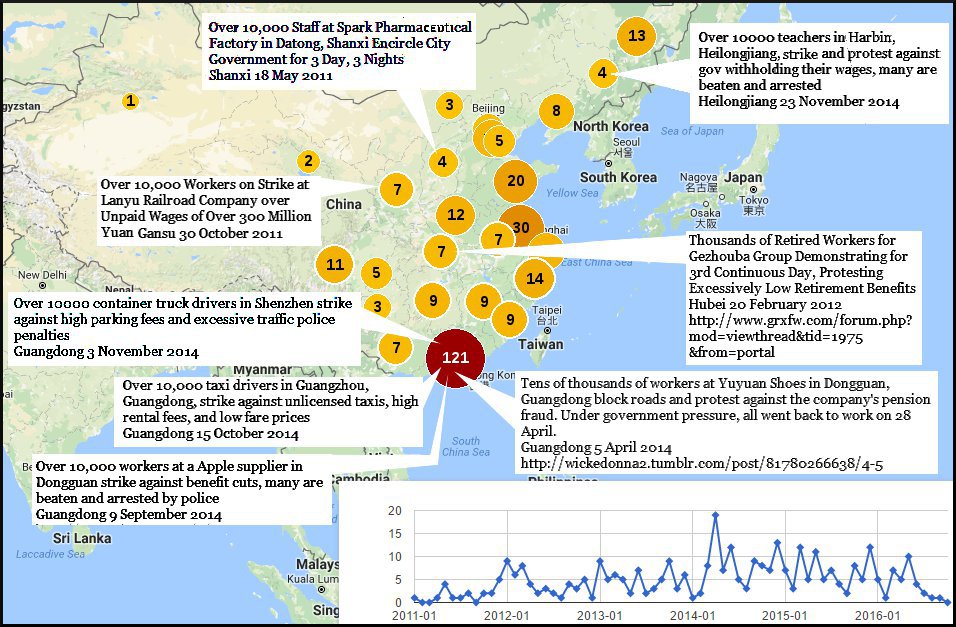 Strikes with more than 1000 participants 2011 - 2016 Over 10000 teachers in Harbin, Heilongjiang, strike and protest against gov withholding their wages, many are beaten and arrested Heilongjiang 23 November 2014 http://wickedonna2.tumblr.com/post/103698297453/11-26 Over 10000 container truck drivers in Shenzhen strike against high parking fees and excessive traffic police penalties Guangdong 3 November 2014 wickedonna2.tumblr.com/post/101804065758/20141 Over 10,000 taxi drivers in Guangzhou, Guangdong, strike against unlicensed taxis, high rental fees, and low fare prices Guangdong 15 October 2014 http://wickedonna2.tumblr.com/post/100141296033/2014 Over 10,000 workers at a Apple supplier in Dongguan strike against benefit cuts, many are beaten and arrested by police Guangdong 9 September 2014 http://news.sina.com.cn/c/2014-09-10/054230816877.shtml Tens of thousands of workers at Yuyuan Shoes in Dongguan, Guangdong block roads and protest against the company's pension fraud. Under government pressure, all went back to work on 28 April. Guangdong 5 April 2014 http://wickedonna2.tumblr.com/post/81780266638/4-5 Thousands of Retired Workers for Gezhouba Group Demonstrating for 3rd Continuous Day, Protesting Excessively Low Retirement Benefits Hubei 20 February 2012 http://www.grxfw.com/forum.php?mod=viewthread&tid=1975&from=portal Over 10,000 Workers on Strike at Lanyu Railroad Company over Unpaid Wages of Over 300 Million Yuan Gansu 30 October 2011 http://money.163.com/11/1029/05/7HGRELSS002526O5.html Over 10,000 Staff at Spark Pharmaceutical Factory in Datong, Shanxi Encircle City Government for 3 Day, 3 Nights Shanxi 18 May 2011 http://grbbs.net/thread-10270-1-1.html 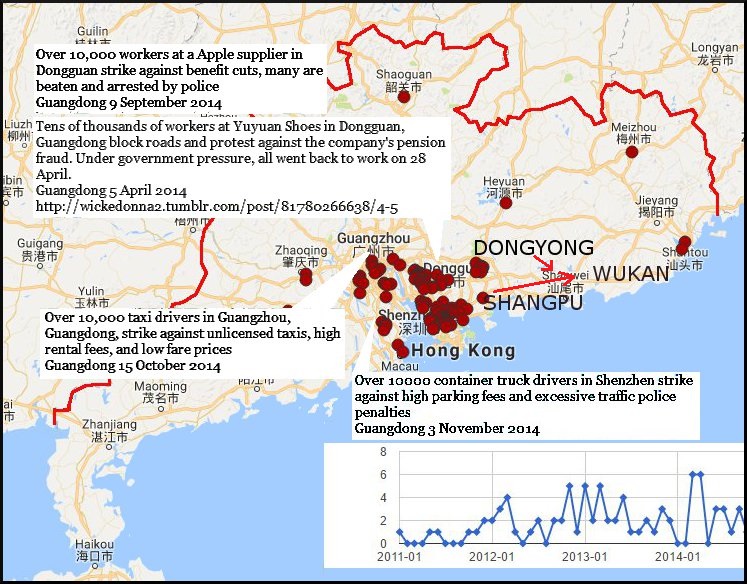 Major Strikes Guangdong 2011-2016 Table of strikes with more that 1000 participants 2011 - 2016 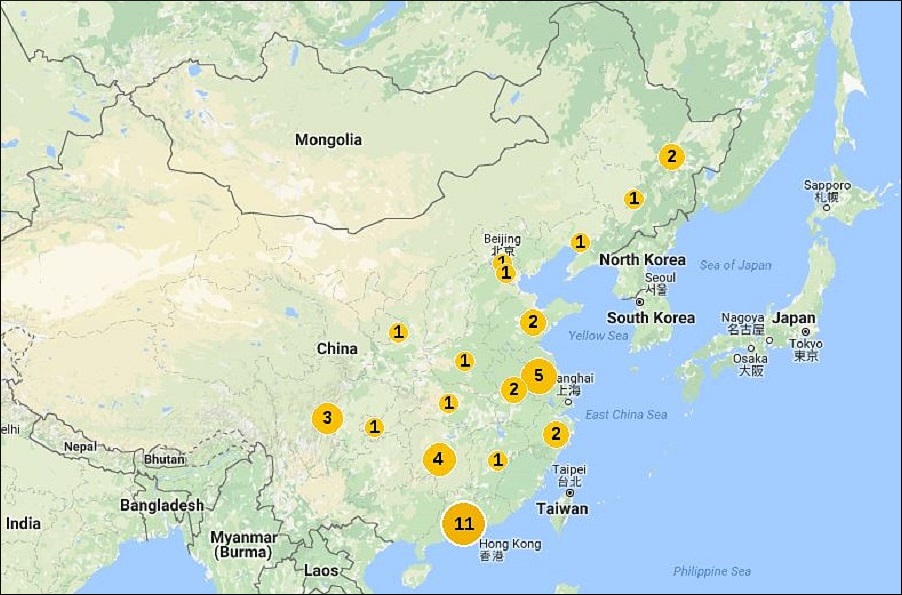 Major strikes with more than 10000 participants 2016 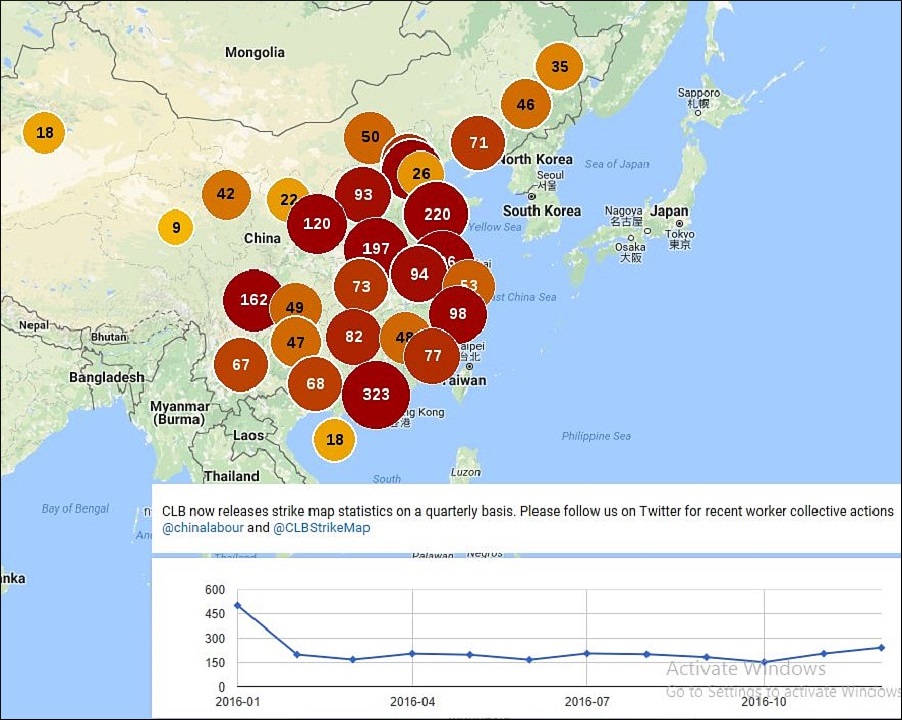 All strikes 2016 FORCED EVICTIONS IN CHINAForced eviction in the People's Republic of China refers to the practice of involuntary land requisitions from the citizenry, typically in order to make room for development projects. In many instances, government authorities working in collusion with private developers seize land from villagers, often with little to no compensation. Forced evictions are particularly common in rural areas, and are a major source of unrest and public protest. By some estimates, up to 65 percent of the 180,000 annual "mass incidents" in China stem from grievances over forced evictions. Citizens who resist or protest the evictions have reportedly been subjected to harassment, beatings, or detention. The rate of forced evictions has grown significantly since the 1990s, as city and county-level governments have increasingly come to rely on land sales as an important source of revenue. In 2011, the Financial Times reported that 40 percent of local government revenue comes from land sales. Guan Qingyou, a professor at Tsinghua University, estimated that land sales accounted for 74 percent of local government income in 2010.Forced evictions are a common catalyst for organized protests and demonstrations. According to some estimates, as much as 65 percent of the estimated 180,000 annual "mass incidents" (protests) in China stem from grievances over forced evictions. Notable examples of large-scale demonstrations against forced evictions include the December 2011 protests in the Southern village of Wukan, which resulted in the temporary expulsion of Communist Party authorities, and the 2005 Dongzhou protests, which ended with the shooting deaths of several protesting villagers by armed police. https://en.wikipedia.org/wiki/Forced_evictions_in_China 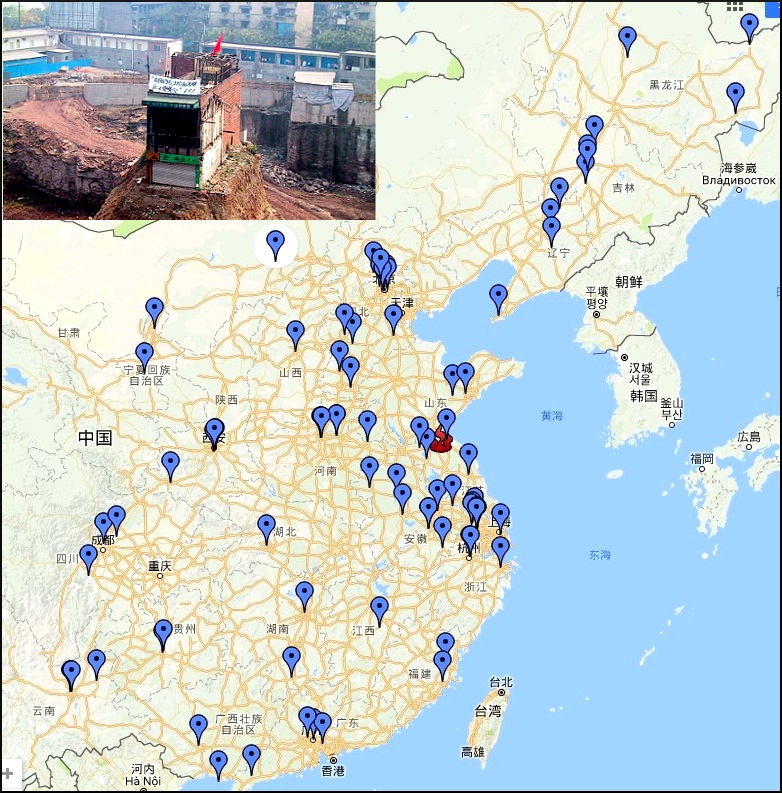
China’s Blood-Stained Property Map An interactive, participatory map project aims to show each and every violent land grab incident in China. |
 The EJ Atlas is a teaching, networking and advocacy resource. Strategists, activist organizers, scholars, and teachers will find many uses for the database, as well as citizens wanting to learn more about the often invisible conflicts taking place.
1. The Fujia Petrochemical Paraxylene (PX) Plant protest in Dalian, Liaoning,
China 2 Waste incineration plant in Hangzhou, China 3 Controversy over planned paraxylene (PX) plant expansion in Ningbo, Zhejiang,
China 4 Yongxing Cancer Village near Likeng Landfill and Incinerators in Guangdong
Province, China 5 Violent protests against planned paraxylene (PX) plant in Maoming, Guangdong,
China 6 Heavy Metal Pollution in Quijing, Yunnan, China 7 Peaceful students march against copper mine in Dawu, Tibet 8 Paraxylene (PX) plant expansion in Pengzhou, Sichuan, China |
|
MORE INFORMATION BY REGION WESTERN CHINA NORTHERN CHINA SOUTHERN CHINA |
| LINKS TO INFORMATION ON PROTESTS IN CHINA
China Labour Bulletin http://wickedonna2.tumblr.com/ http://chinadigitaltimes.net/2010/10/china%E2%80%99s-blood-stained-property-map/ Opposition to coal in China |
PROTEST MAPPING FOR CHINA
XXXXXXXXXXXXXXXXXXXXXXXXXXXXXXXXXXXXXXXXXXXXXXXXXXX
XXXXXXXXXXXXXXXXXXXXXXXXXXXXXXXXXXXXXXXXXXXXXXXXXXX
XXXXXXXXXXXXXXXXXXXXXXXXXXXXXXXXXXXXXXXXXXXXXXXXXXX
XXXXXXXXXXXXXXXXXXXXXXXXXXXXXXXXXXXXXXXXXXXXXXXXXXX
XXXXXXXXXXXXXXXXXXXXXXXXXXXXXXXXXXXXXXXXXXXXXXXXXXX
XXXXXXXXXXXXXXXXXXXXXXXXXXXXXXXXXXXXXXXXXXXXXXXXXXX
XXXXXXXXXXXXXXXXXXXXXXXXXXXXXXXXXXXXXXXXXXXXXXXXXXX
XXXXXXXXXXXXXXXXXXXXXXXXXXXXXXXXXXXXXXXXXXXXXXXXXXX
Back |
Make a free website with Yola
